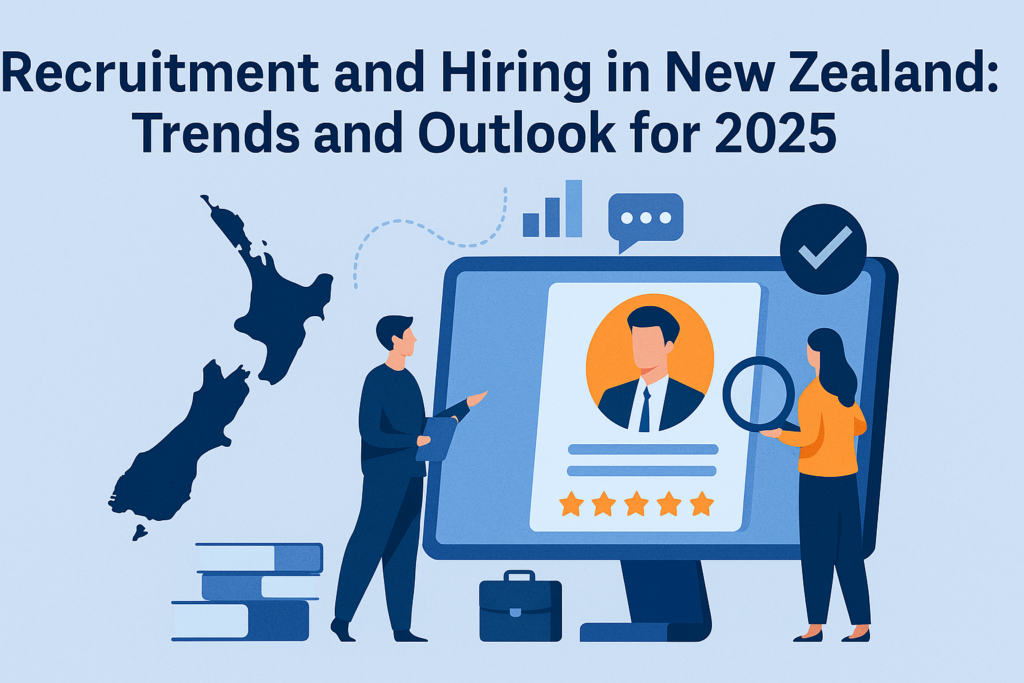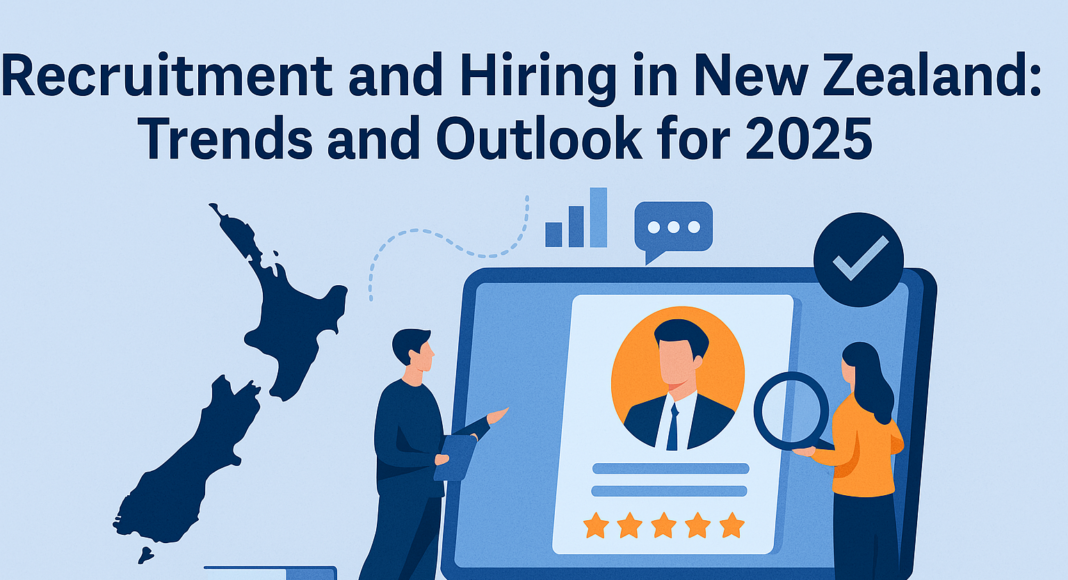Key Takeaways
- Skills shortages remain a major challenge, with high demand for professionals in IT, healthcare, engineering, and skilled trades driving competitive hiring trends.
- Technology is transforming recruitment, with AI-driven hiring tools, remote work adoption, and skills-based assessments reshaping talent acquisition.
- Competitive salaries and employer branding are crucial, as businesses must offer attractive compensation and workplace culture to secure top talent in 2025.
The recruitment landscape in New Zealand is undergoing a rapid transformation as businesses, job seekers, and policymakers adapt to evolving economic conditions, technological advancements, and shifting workforce expectations.
As we step into 2025, organizations across various industries must stay ahead of emerging hiring trends to secure top talent, maintain a competitive edge, and navigate the challenges of a dynamic labor market.
New Zealand’s job market has been influenced by a range of factors, including population growth, immigration policies, skills shortages, remote work adoption, and the increasing role of artificial intelligence (AI) in recruitment.

Employers are rethinking traditional hiring strategies and embracing innovative approaches to attract, assess, and retain candidates.
Simultaneously, job seekers are prioritizing flexible work arrangements, career development opportunities, and workplace well-being, reshaping the way businesses approach talent acquisition.
The COVID-19 pandemic left a lasting impact on employment trends, accelerating the shift toward digital recruitment methods, virtual interviews, and hybrid work models. As the economy stabilizes, industries such as technology, healthcare, construction, and renewable energy are experiencing high demand for skilled professionals. However, competition for top talent remains fierce, requiring recruiters to refine their strategies and leverage data-driven insights to make informed hiring decisions.
In this comprehensive guide, we will explore key recruitment and hiring trends shaping New Zealand’s workforce in 2025. We will examine the role of AI and automation in streamlining recruitment processes, the continued rise of flexible and remote work opportunities, the increasing emphasis on diversity, equity, and inclusion (DEI) initiatives, and the evolving expectations of job seekers. Additionally, we will provide insights into industry-specific hiring challenges and opportunities, helping businesses and HR professionals navigate the complexities of talent acquisition in the coming year.
Whether you are an employer looking to refine your recruitment strategies, an HR professional seeking to stay updated on hiring trends, or a job seeker aiming to understand the shifting job market, this guide will offer valuable insights to help you stay ahead in 2025. Let’s delve into the key trends and outlook for recruitment and hiring in New Zealand, equipping you with the knowledge needed to make informed decisions in an ever-changing employment landscape.
Before we venture further into this article, we would like to share who we are and what we do.
About 9cv9
9cv9 is a business tech startup based in Singapore and Asia, with a strong presence all over the world.
With over nine years of startup and business experience, and being highly involved in connecting with thousands of companies and startups, the 9cv9 team has listed some important learning points in this overview of the Recruitment and Hiring in New Zealand: Trends and Outlook for 2025.
If your company needs recruitment and headhunting services to hire top-quality employees, you can use 9cv9 headhunting and recruitment services to hire top talents and candidates. Find out more here, or send over an email to [email protected].
Or just post 1 free job posting here at 9cv9 Hiring Portal in under 10 minutes.
Recruitment and Hiring in New Zealand: Trends and Outlook for 2025
- Recruitment and Hiring in New Zealand: Trends and Outlook for 2025
- Sector Spotlight: Industries with High Recruitment Demand in New Zealand (2025)
- Employment Statistics and Labor Force Dynamics in New Zealand (2025)
- Critical Skills and High-Demand Job Roles in New Zealand (2025)
- Evolving Recruitment Strategies and Platforms in New Zealand (2025)
- Salary and Compensation Benchmarks in New Zealand (2025)
- Technological Advancements Transforming Recruitment and Hiring in New Zealand (2025)
- Opportunities in New Zealand’s 2025 Hiring Landscape
- Strategic Implications for New Zealand’s 2025 Labor Market
1. Recruitment and Hiring in New Zealand: Trends and Outlook for 2025
As New Zealand’s labor market evolves, businesses, policymakers, and job seekers must stay informed about the economic forces, workforce dynamics, and emerging hiring trends shaping the country’s employment landscape in 2025. A combination of global economic recovery, domestic policy shifts, and industry-specific developments is influencing recruitment strategies and labor force participation.
This analysis provides a comprehensive overview of the economic outlook, hiring trends, workforce challenges, and key drivers shaping recruitment in New Zealand for the year ahead.
Economic Landscape and Employment Projections
Macroeconomic Performance and GDP Growth
New Zealand’s economy is expected to experience a moderate recovery in 2025, driven by lower borrowing costs, resilient primary industries, and increased household spending. However, economic forecasts indicate a mixed outlook:
- International Monetary Fund (IMF) Outlook: The IMF anticipates a real GDP growth of 1.4% in 2025, with a more accelerated recovery of 2.7% projected for 2026.
- Westpac Economic Forecasts: A 2.5% GDP growth is projected for 2025, rising to 3% in 2026, fueled by reduced interest rates and business confidence.
- NZIER Consensus Forecasts: A -0.8% economic contraction is expected for the year ending March 2025, followed by a recovery to 2.1% in 2026.
- Government Budget Policy Statement 2025: The economic outlook is expected to improve from mid-2025, with declining unemployment rates and stronger consumer spending.
- Reserve Bank of New Zealand (RBNZ) Policy Adjustments: The RBNZ has introduced multiple Official Cash Rate (OCR) reductions, bringing it down to 3.75% as of early 2025, with further cuts being considered to stimulate growth.
Employment Indicators and Labor Market Trends
Despite economic recovery efforts, New Zealand’s labor market continues to face challenges related to job creation, workforce participation, and unemployment levels.
- Job Creation and Filled Jobs:
- As of February 2025, seasonally adjusted filled jobs remained unchanged from January 2025, highlighting a temporary slowdown in hiring across all industries.
- Compared to February 2024, filled jobs declined by 1.5%, equating to a net loss of 35,090 positions.
- Unemployment Trends:
- The unemployment rate increased to 5.1% in Q4 2024, reaching the highest level since September 2020.
- Forecasts suggest a potential peak of 5.3% to 5.5% in early 2025, with gradual improvements expected in the latter half of the year.
- Workforce Participation Rate:
- The labor force participation rate stood at 71.3% in December 2024, slightly rising from 70.9% in the previous quarter.
- Projections indicate minor fluctuations, stabilizing at around 70.5% in 2026 and increasing to 71.5% by 2027.
Key Recruitment Trends in 2025
1. Digital Transformation in Hiring Processes
Recruitment strategies in New Zealand are becoming increasingly technology-driven, with businesses leveraging advanced tools to enhance efficiency and decision-making.
- AI-Powered Recruitment: Machine learning algorithms and AI-driven applicant tracking systems (ATS) are being widely adopted to streamline resume screening, candidate matching, and interview scheduling.
- Automation of HR Functions: Chatbots and automated assessment tools are reducing time-to-hire by efficiently managing initial candidate interactions and pre-employment testing.
- Predictive Analytics for Talent Acquisition: Companies are utilizing workforce analytics to anticipate hiring needs, assess skills shortages, and improve long-term workforce planning.
2. Shift Toward Hybrid and Remote Work Models
Flexible work arrangements remain a dominant trend, influenced by evolving employee expectations and business adaptation to digital work environments.
- Expansion of Remote Work Opportunities: Companies are increasingly hiring for remote and hybrid roles, particularly in technology, finance, and creative industries.
- Emphasis on Work-Life Balance: Employers are enhancing flexibility to attract top talent, offering compressed workweeks, remote work stipends, and mental health support programs.
- Regulatory and Compliance Considerations: Businesses must navigate evolving labor laws regarding remote employee taxation, cybersecurity policies, and workplace health and safety regulations.
3. Addressing Skills Shortages and Talent Gaps
Certain sectors in New Zealand are facing persistent skills shortages, necessitating strategic workforce planning and upskilling initiatives.
- High-Demand Sectors:
- Technology & IT: Demand for software developers, cybersecurity specialists, and AI engineers continues to outpace supply.
- Healthcare: Aging demographics are driving recruitment needs for nurses, aged-care professionals, and medical specialists.
- Construction & Infrastructure: Skilled tradespeople, civil engineers, and project managers remain in short supply amid ongoing urban development projects.
- Renewable Energy: Growth in sustainability initiatives is fueling demand for professionals in solar energy, wind power, and environmental engineering.
- Workforce Development Initiatives:
- Government programs and private sector partnerships are investing in vocational training, apprenticeships, and technology upskilling to address skills mismatches.
- Businesses are offering tuition reimbursement, leadership training, and internal career mobility programs to retain employees and enhance workforce capabilities.
4. The Rise of Diversity, Equity, and Inclusion (DEI) Strategies
Organizations in New Zealand are increasingly prioritizing diversity and inclusion in recruitment practices to foster innovation and workplace equity.
- Inclusive Hiring Policies: Companies are implementing blind recruitment processes and structured interviews to mitigate bias in hiring decisions.
- Focus on Māori and Pasifika Representation: Government initiatives and corporate programs are working to increase employment opportunities for Māori and Pasifika workers in skilled and leadership roles.
- Generational Workforce Considerations: With millennials and Gen Z comprising a significant portion of the labor market, organizations are adapting workplace cultures to align with younger employees’ values, including environmental sustainability, ethical business practices, and flexible career paths.
Future Outlook: What Lies Ahead for Recruitment in New Zealand?
As 2025 unfolds, the recruitment landscape in New Zealand will be shaped by a combination of economic recovery efforts, technological advancements, workforce expectations, and policy adjustments. Key takeaways for businesses and job seekers include:
- Economic stabilization is expected in the latter half of 2025, easing hiring uncertainties and supporting job growth.
- Technological integration in recruitment will continue expanding, making digital hiring processes more data-driven and efficient.
- Flexible work arrangements will remain a priority, influencing hiring strategies and employee retention initiatives.
- Investment in workforce upskilling and reskilling will be crucial for addressing talent shortages and ensuring long-term labor market sustainability.
- Employers that emphasize diversity, equity, and inclusion will gain a competitive edge in attracting and retaining a highly skilled workforce.
By understanding and adapting to these trends, businesses can build stronger talent pipelines, job seekers can align their skill sets with emerging opportunities, and policymakers can refine labor strategies to support New Zealand’s evolving workforce in 2025 and beyond.
2. Sector Spotlight: Industries with High Recruitment Demand in New Zealand (2025)
New Zealand’s labor market is undergoing a period of transformation, with several key industries experiencing acute workforce shortages. As businesses expand, infrastructure projects progress, and demographic shifts alter service demands, recruitment efforts across various sectors are intensifying. These industries not only drive economic growth but also play a crucial role in shaping the country’s long-term workforce strategy.
A number of professions remain on the government’s skills shortage lists, underscoring the need for both domestic workforce development and international talent acquisition. This section examines the primary sectors poised for substantial recruitment activity throughout 2025, highlighting specific roles in high demand and the underlying factors contributing to these workforce needs.
1. Information Technology (IT) and Telecommunications
As New Zealand embraces digital transformation across industries, the demand for skilled IT and telecommunications professionals continues to surge. Businesses are increasingly reliant on cloud computing, artificial intelligence (AI), and cybersecurity to maintain operational efficiency and data security, creating sustained hiring demand for experts in these domains.
- High-Demand Roles:
- Software engineers and web developers
- ICT project managers
- Cybersecurity specialists (projected 27% increase in demand)
- Database administrators and system analysts
- Multimedia and UX/UI specialists
- Data scientists (demand expected to rise by 24%)
- AI and machine learning engineers
- Cloud computing specialists
- Key Drivers of Demand:
- Expansion of e-commerce, fintech, and SaaS (Software-as-a-Service) industries
- Growing concerns over data security and privacy regulations
- Government-led digital infrastructure initiatives and 5G expansion
- Increased remote work adoption, necessitating robust IT support frameworks
2. Healthcare and Social Services
The healthcare sector remains one of the most critical pillars of New Zealand’s workforce, yet persistent shortages in key medical professions continue to challenge service delivery. The country’s aging population and increasing demand for specialized healthcare services have led to intensified recruitment efforts, particularly in nursing, primary care, and mental health support.
- High-Demand Roles:
- Registered nurses (specialties: mental health, aged care, critical care, pediatrics)
- General practitioners and medical specialists
- Midwives and maternal healthcare providers
- Clinical psychologists and mental health professionals
- Medical laboratory scientists and radiographers
- Aged care workers and disability support providers
- Key Drivers of Demand:
- Rising life expectancy and increased healthcare needs among elderly populations
- Government efforts to improve access to mental health and disability services
- Inclusion of healthcare professionals on New Zealand’s Green List, streamlining visa pathways for skilled migrants
- Ongoing healthcare workforce shortages exacerbated by post-pandemic burnout and attrition
3. Engineering and Construction
Infrastructure development remains a national priority, with significant investment in housing, transportation networks, and sustainability-focused projects. As urban expansion continues and new construction initiatives emerge, the demand for engineering and skilled trades professionals is at an all-time high.
- High-Demand Roles:
- Civil, structural, and geotechnical engineers
- Electrical and mechanical engineers
- Construction project managers and quantity surveyors
- Skilled tradespeople, including electricians, plumbers, and welders
- Health and safety officers specializing in construction sites
- Key Drivers of Demand:
- Large-scale infrastructure projects, including highway expansions and rail network upgrades
- Continued efforts to increase housing supply in response to population growth
- Government investment in renewable energy and sustainable urban development
- Shortages of skilled tradespeople due to an aging workforce and lower apprenticeship participation
4. Skilled Trades and Agricultural Workforce
New Zealand’s primary industries, including agriculture, forestry, and manufacturing, remain integral to economic stability and export performance. However, ongoing labor shortages in skilled trades and agribusiness present challenges to production efficiency and supply chain operations.
- High-Demand Roles:
- Electricians, plumbers, and HVAC (heating, ventilation, and air conditioning) specialists
- Automotive technicians and diesel mechanics
- Dairy farm managers and agribusiness supervisors
- Heavy machinery operators and forestry workers
- Manufacturing and food processing specialists
- Key Drivers of Demand:
- New Zealand’s reliance on agricultural exports, driving continued demand for farm labor and agribusiness expertise
- Advancements in agri-tech and precision farming, requiring specialized technical skills
- Workforce shortages in mechanical and automotive trades, impacting supply chain and transport sectors
- Increased emphasis on sustainable farming and forestry management practices
5. Education and Teaching
New Zealand’s education sector faces a growing teacher shortage, particularly in rural areas and specialized disciplines. The government has implemented recruitment incentives and visa pathways to attract both domestic and international teaching professionals to fill critical vacancies.
- High-Demand Roles:
- Primary and secondary school teachers
- Special education and early childhood educators
- Mathematics, science, and technology subject specialists
- School counselors and educational psychologists
- Key Drivers of Demand:
- Increasing student enrollment and the need for smaller class sizes
- Aging teaching workforce, leading to higher retirement rates
- Government-backed initiatives to attract international educators, including Straight to Residence Pathways for primary teachers
- Expansion of early childhood education programs, creating additional demand for qualified professionals
Conclusion: Navigating Workforce Challenges in 2025
As recruitment activity intensifies across these key sectors, businesses and policymakers must adopt proactive workforce planning strategies to address ongoing skills shortages. Employers are increasingly investing in:
- Training and upskilling programs to enhance the domestic talent pipeline
- International recruitment initiatives to attract skilled migrants for critical roles
- Technology-driven hiring solutions, such as AI-powered talent matching and remote workforce integration
- Retention-focused workplace policies, including flexible work arrangements and employee well-being programs
For job seekers, aligning career development efforts with high-demand industries can significantly improve employability prospects in 2025 and beyond. By leveraging government-supported skill development programs and industry-specific training, professionals can position themselves strategically in New Zealand’s evolving labor market.
As the country moves forward, a collaborative approach between businesses, educational institutions, and policymakers will be crucial in bridging workforce gaps and ensuring sustained economic growth.
3. Employment Statistics and Labor Force Dynamics in New Zealand (2025)
New Zealand’s labor market is experiencing a period of adjustment, shaped by economic shifts, sector-specific demand fluctuations, and broader demographic trends. While employment rates indicate a gradual recovery, the nation continues to navigate workforce challenges, including regional disparities, sectoral job losses, and youth employment struggles.
An analysis of key labor force indicators, including employment rates, unemployment trends, sectoral hiring patterns, and demographic shifts, provides valuable insights into the evolving job market landscape. These trends will be critical for policymakers, employers, and job seekers as they navigate the employment outlook for 2025.
1. Employment Rate and Workforce Participation
- The employment rate in New Zealand stood at 67.4% in the December 2024 quarter.
- Forecasts from the Organisation for Economic Co-operation and Development (OECD) project a gradual increase in employment levels, with the rate for individuals aged 15 to 74 expected to reach 73.5% in 2025 and 73.98% in 2026.
- These projections suggest a gradual strengthening of the job market, despite economic uncertainties and previous contraction in key industries.
- The labor force participation rate, which reflects the percentage of working-age individuals either employed or actively seeking employment, stood at 71.3% in December 2024, slightly up from 71.1% in the previous quarter.
- Short-term forecasts indicate a minor decline to approximately 70.8% in the first quarter of 2025, though long-term trends suggest participation levels will remain relatively stable.
2. Unemployment Trends and Future Outlook
- The unemployment rate in New Zealand reached 5.1% in the December 2024 quarter, marking its highest level since September 2020.
- Various economic forecasts suggest a potential rise to 5.3% to 5.5% in the first half of 2025, largely attributed to slower economic recovery in some sectors.
- However, unemployment levels are projected to decline in the latter half of 2025, driven by anticipated economic growth, lower borrowing costs, and increased business activity.
- Government initiatives, including targeted workforce development programs and international recruitment efforts, are expected to contribute to a moderate reduction in unemployment levels over the long term.
3. Sectoral Job Market Shifts: Employment Gains and Declines
An analysis of industry-specific employment trends, based on labor market data from February 2025, reveals notable shifts across different sectors:
Industries Experiencing Job Losses:
- Construction: Employment in this sector saw a -6.6% decline compared to February 2024, reflecting a slowdown in residential and commercial building projects.
- Administrative and Support Services: A contraction of -6.5% was observed, likely due to cost-cutting measures in businesses amid economic uncertainty.
- Manufacturing: Job losses of -2.6% highlight ongoing challenges in supply chain disruptions and reduced production output.
Industries Experiencing Job Growth:
- Healthcare and Social Assistance: This sector exhibited the largest employment increase of +1.8%, reflecting sustained demand for medical professionals, aged care workers, and mental health specialists.
- Technology and Digital Services: While not explicitly quantified in the latest data, ongoing trends indicate growing demand for IT and telecommunications roles, particularly in cybersecurity, cloud computing, and software development.
4. Regional Employment Variations
Labor market conditions vary significantly by region, with some areas experiencing sharper declines in employment levels than others. As of early 2025, notable regional job losses compared to the previous year include:
- Auckland: -2.1% decline in filled jobs, reflecting weakened hiring activity in construction, tourism, and service industries.
- Wellington: -2.0% decline, attributed to public sector hiring freezes and restructuring efforts in government agencies.
- Waikato: -0.8% decline, primarily due to fluctuations in agriculture and manufacturing employment.
- Manawatū-Whanganui: -1.5% decrease, highlighting workforce contraction in transport and logistics sectors.
- Bay of Plenty: -1.0% decline, linked to challenges in horticulture and export-dependent industries.
While these regions have faced setbacks, economic recovery efforts and infrastructure investments are expected to support long-term employment stability. Areas with higher reliance on technology, healthcare, and renewable energy sectors may see stronger job market resilience in the coming years.
5. Employment Trends by Age Group
A breakdown of employment shifts by age group reveals disproportionate job losses among younger workers, highlighting challenges in early-career employment stability:
- 15-19 years: -9.9% decrease in employment, reflecting declining availability of entry-level positions and casual jobs.
- 20-24 years: -3.2% decline, likely influenced by reduced hiring in hospitality, retail, and service industries.
- 25-29 years: -4.6% drop, indicating difficulties for young professionals securing stable, long-term employment.
- 30-34 years: -2.8% decline, signaling workforce competition and potential career stagnation.
- 35-39 years: +2.1% increase, making it the only age group experiencing positive employment growth, possibly due to higher demand for experienced professionals in specialized fields.
These trends underscore the importance of targeted youth employment programs, vocational training opportunities, and industry-specific upskilling initiatives to ensure sustainable career progression for younger workers.
Conclusion: Navigating the Evolving Labor Market in 2025
The employment landscape in New Zealand for 2025 reflects a complex interplay of economic recovery efforts, sector-specific shifts, and demographic employment trends. While the job market shows signs of resilience, continued challenges—including rising unemployment in the first half of the year, regional job losses, and declining youth employment—necessitate strategic workforce planning.
Key priorities for businesses, policymakers, and job seekers in the coming year include:
- Enhancing workforce adaptability through reskilling and upskilling initiatives in high-growth industries.
- Supporting youth employment through apprenticeships, internships, and tailored job placement programs.
- Leveraging government incentives for workforce development in critical sectors such as healthcare, technology, and renewable energy.
- Improving regional employment resilience by diversifying economic activities and investing in infrastructure and innovation-driven projects.
By addressing these labor force challenges with proactive employment strategies, New Zealand’s job market is well-positioned for gradual recovery and long-term workforce sustainability.
4. Critical Skills and High-Demand Job Roles in New Zealand (2025)
As New Zealand’s labor market evolves in response to technological advancements, demographic changes, and economic recovery efforts, the demand for a diverse range of skills continues to grow. The year 2025 is expected to witness a heightened emphasis on technical expertise, industry-specific certifications, and essential soft skills that enable professionals to thrive in an increasingly dynamic work environment.
Beyond traditional job roles, emerging industries and disruptive technologies are driving the need for specialized talent, particularly in areas such as artificial intelligence, sustainability, and digital infrastructure. Moreover, the New Zealand government’s Green List remains instrumental in streamlining residency pathways for skilled professionals in critical sectors, ensuring that workforce shortages are addressed effectively.
1. Essential Skills Shaping the 2025 Job Market
The evolving employment landscape underscores the significance of a combination of technical capabilities, adaptive soft skills, and industry-specific expertise.
Technical and Digital Proficiencies
- Artificial Intelligence (AI) and Machine Learning: Increasing automation across industries has fueled the need for AI specialists, particularly in fields like predictive analytics, automation, and natural language processing.
- Data Science and Cybersecurity: As data-driven decision-making becomes central to business strategies, professionals skilled in big data analytics, cybersecurity risk management, and cloud security solutions are in growing demand.
- Software Development and UX/UI Design: With digital transformation accelerating across sectors, expertise in full-stack development, mobile applications, cloud computing, and user experience (UX) optimization remains highly sought after.
- Blockchain and Internet of Things (IoT): Emerging technologies are gaining prominence, leading to a rise in demand for blockchain developers, IoT engineers, and smart technology specialists.
Soft Skills Driving Professional Success
Beyond technical expertise, employers increasingly value interpersonal and adaptive skills that enhance workplace efficiency and collaboration:
- Problem-Solving and Critical Thinking: The ability to analyze complex situations and implement effective solutions is crucial in fast-paced industries.
- Communication and Emotional Intelligence: Professionals who excel in team collaboration, client engagement, and cross-functional communication stand out in competitive job markets.
- Time Management and Adaptability: With workplaces evolving rapidly, employees who can prioritize tasks efficiently and navigate changing business landscapes are highly valued.
Industry-Specific Qualifications and Certifications
Several professions require specialized training and formal qualifications to meet industry standards:
- Healthcare: Registered nurses, general practitioners, and aged care workers must meet certification and licensing requirements to practice in New Zealand.
- Engineering and Construction: Professionals such as civil engineers, structural engineers, and construction project managers need accreditation from industry regulatory bodies.
- Skilled Trades: Electricians, plumbers, and automotive technicians must obtain trade certifications and apprenticeships to secure employment in these sectors.
2. High-Demand Job Roles Across Key Sectors
Several job roles have been identified as experiencing strong demand throughout 2025, aligning with New Zealand’s economic priorities and workforce needs.
Technology and Digital Innovation
- Software Engineers and Developers – Expertise in web development, mobile applications, and cloud-based platforms is in high demand.
- Data Scientists and AI Specialists – Companies are seeking professionals skilled in big data analytics, machine learning algorithms, and AI-driven business solutions.
- Cybersecurity Specialists – The rise in cyber threats has increased demand for information security analysts and ethical hackers.
- Blockchain Developers and IoT Engineers – The expanding FinTech and smart infrastructure sectors require experts in blockchain-based applications and IoT device integration.
Healthcare and Social Services
- Registered Nurses (Mental Health, Aged Care, Critical Care, Paediatrics) – The ongoing healthcare workforce shortage has reinforced the need for nursing professionals across various specializations.
- General Practitioners and Medical Specialists – The demand for family physicians, surgeons, and emergency care doctors continues to rise.
- Aged Care Workers and Clinical Psychologists – An aging population and increased focus on mental health services have created sustained job opportunities in these fields.
Engineering and Construction
- Civil Engineers and Structural Engineers – Major infrastructure development projects are driving demand for skilled engineers.
- Construction Project Managers and Quantity Surveyors – Large-scale projects, including urban redevelopment and transportation network expansions, require experienced project leaders.
Skilled Trades and Essential Services
- Electricians and Plumbers – These roles remain fundamental to both residential and commercial infrastructure development.
- Automotive Technicians and Diesel Mechanics – The transportation and heavy machinery industries continue to seek skilled tradespeople.
Education and Training
- Primary and Secondary School Teachers – A national shortage of educators, particularly in STEM subjects and special education, has led to increased recruitment efforts.
- Early Childhood Educators – Government initiatives aim to expand access to early childhood education, driving the need for qualified teachers in this field.
3. The Role of the Green List in Addressing Skills Shortages
New Zealand’s Green List serves as a vital tool in mitigating critical labor shortages by offering streamlined residency pathways for professionals in high-demand occupations.
- Key Occupations on the Green List:
- Healthcare professionals (Registered Nurses, General Practitioners, Medical Laboratory Scientists)
- Engineering specialists (Civil Engineers, Electrical Engineers, Quantity Surveyors)
- Construction professionals (Project Managers, Plumbers, Electricians)
- IT experts (Software Developers, Cybersecurity Specialists, Data Scientists)
- Recent Updates to the Green List (2025):
- Primary school teachers have been added to the Straight to Residence Pathway, underscoring the urgent need for qualified educators.
- New provisions have been introduced to attract professionals in sustainability-focused industries, including renewable energy engineers and environmental scientists.
- Pathways for Skilled Migrants:
- The Straight to Residence Visa provides immediate residency eligibility for specific high-demand occupations.
- The Work to Residence Visa offers a two-year pathway to residency for skilled professionals in industries facing persistent workforce shortages.
Conclusion: Navigating Workforce Opportunities in 2025
As New Zealand’s employment landscape evolves, professionals and job seekers must align their skill sets with emerging industry trends. The growing emphasis on digital transformation, healthcare expansion, infrastructure development, and education reform presents numerous opportunities for those equipped with technical expertise, industry qualifications, and critical soft skills.
To capitalize on these workforce opportunities, individuals should:
- Invest in continuous upskilling to meet the demands of an increasingly tech-driven economy.
- Obtain industry-specific certifications that enhance employability and career growth prospects.
- Leverage government programs such as the Green List residency pathways for skilled migration opportunities.
- Adapt to workforce shifts by developing interdisciplinary skills that cater to multiple industries.
By embracing ongoing professional development, adaptability, and strategic career planning, New Zealand’s workforce can thrive in a rapidly evolving economic environment, ensuring both individual success and national labor market resilience.
5. Evolving Recruitment Strategies and Platforms in New Zealand (2025)
As the job market in New Zealand undergoes continuous transformation, organizations are adapting their recruitment strategies to enhance talent acquisition, improve candidate experience, and address skills shortages. Employers are leveraging a diverse mix of digital platforms, artificial intelligence (AI)-driven solutions, and targeted engagement methods to attract, assess, and hire top talent.
Traditional hiring methods are being complemented by innovative approaches that emphasize skills-based recruitment, employer branding, and proactive talent sourcing. Companies are prioritizing cultural alignment, workforce diversity, and technological efficiency to build a strong, future-ready workforce.
1. Digital Platforms and Online Job Boards
The digitalization of recruitment has made online job platforms the cornerstone of hiring strategies, allowing organizations to connect with both active and passive candidates.
Popular Job Boards and Digital Hubs
- Seek and Trade Me Jobs: These platforms remain the primary choice for active job seekers, offering a comprehensive database of job listings across multiple industries.
- LinkedIn: Beyond traditional job postings, LinkedIn is widely used for networking, employer branding, and passive talent sourcing. The platform’s AI-driven candidate matching and recruitment marketing tools have become instrumental in modern hiring processes.
- Industry-Specific Platforms: Niche job boards tailored to healthcare, IT, education, and skilled trades are gaining traction, providing targeted recruitment opportunities.
Rise of AI-Powered Recruitment Technology
- AI-driven Candidate Screening: Automated tools analyze resumes, skills, and experiences to identify the most suitable applicants, reducing human bias and increasing efficiency.
- Chatbots and Virtual Assistants: AI chatbots are transforming candidate interactions by automating application queries, scheduling interviews, and providing real-time updates.
- Predictive Hiring Analytics: AI tools are being employed to forecast hiring trends, assess candidate potential, and improve workforce planning.
2. Employer Branding and Talent Attraction
With job seekers prioritizing workplace values, culture, and career development opportunities, employer branding has become a key differentiator in attracting top talent.
Building a Strong Employer Brand
- Showcasing Organizational Culture: Companies are actively promoting their workplace environment, diversity and inclusion efforts, and employee success stories to attract job seekers.
- Company Reviews and Employee Advocacy: Platforms such as Glassdoor and Indeed allow potential hires to assess company culture through employee reviews and testimonials.
- Purpose-Driven Recruitment: Businesses emphasizing corporate social responsibility, sustainability, and employee well-being are gaining a competitive edge in talent attraction.
3. Shift Towards Skills-Based Hiring
A growing number of employers are moving away from traditional qualification-based recruitment and focusing more on skills, competencies, and practical expertise.
Key Trends in Skills-Based Hiring
- Competency Assessments Over Degrees: Employers are placing greater importance on demonstrated abilities rather than rigid academic requirements.
- Micro-Credentials and Certifications: Short-term training programs and certifications in emerging fields such as AI, cybersecurity, and sustainability are being prioritized.
- Transferable Skills Valuation: Candidates with problem-solving, critical thinking, adaptability, and leadership skills are increasingly favored across industries.
This shift is expanding access to a more diverse talent pool, allowing individuals from non-traditional education backgrounds, self-taught professionals, and career changers to secure employment in high-demand roles.
4. Engaging Passive Candidates and Proactive Sourcing
With many skilled professionals not actively seeking new opportunities, companies are focusing on proactive talent engagement strategies to identify and attract passive candidates.
Methods for Reaching Passive Talent
- LinkedIn and Professional Networking: Recruiters utilize direct outreach, personalized job offers, and industry connections to engage passive job seekers.
- Employee Referral Programs: Organizations are incentivizing internal referrals to tap into hidden talent pools through existing employees.
- Talent Pipelines and Database Management: Companies are maintaining candidate pools for future hiring needs, ensuring a steady flow of qualified professionals when vacancies arise.
5. The Role of Recruitment Agencies and Outsourcing
Recruitment agencies remain integral to connecting employers with specialized talent, particularly for roles that require technical expertise, niche industry knowledge, or executive-level experience.
Benefits of Recruitment Agencies
- Specialized Industry Expertise: Agencies provide access to pre-screened candidates with relevant skills and qualifications in fields such as IT, healthcare, engineering, and finance.
- Time and Cost Efficiency: Outsourcing recruitment processes reduces hiring timelines and administrative burdens for employers.
- Contract and Temporary Staffing Solutions: Businesses can leverage flexible workforce solutions, particularly for project-based roles, seasonal employment, and high-demand periods.
Conclusion: Future-Ready Recruitment in 2025
The landscape of recruitment in New Zealand is evolving rapidly, driven by digital transformation, skills-focused hiring, and a greater emphasis on employer branding. Companies must adapt their strategies to leverage technology, engage diverse talent, and enhance the candidate experience to remain competitive in an ever-changing job market.
By integrating AI-driven hiring tools, prioritizing skills over qualifications, and proactively sourcing talent, employers can build resilient, high-performing teams that align with the future of work in New Zealand.
6. Salary and Compensation Benchmarks in New Zealand (2025)
The salary landscape in New Zealand for 2025 is shaped by multiple economic, industry-specific, and labor market factors. Compensation trends reflect the evolving demand for skilled professionals, inflationary pressures, and shifts in workforce expectations, making salary benchmarks a crucial consideration for both employers and job seekers.
While moderate wage growth of approximately 3% is projected across most industries, sectors experiencing acute talent shortages—such as IT, healthcare, engineering, and construction—are likely to see above-average salary increases due to heightened competition for qualified candidates.
1. Industry-Specific Salary Trends
Technology and IT Sector
- The IT sector remains one of the most lucrative fields, offering attractive salary packages due to the high demand for digital expertise and ongoing technological advancements.
- The average IT salary in New Zealand is approximately NZ$92,000 per year, though earnings vary significantly based on specialization and experience.
- High-demand roles such as cybersecurity managers, cloud architects, and software development leads can command salaries exceeding NZ$185,000 per annum.
Healthcare and Medical Professions
- With persistent workforce shortages in healthcare, salaries for medical professionals, registered nurses, and aged care specialists are expected to see steady growth.
- Specialists in mental health, emergency care, and intensive care nursing are among the highest earners in the healthcare sector.
- Competitive remuneration, alongside relocation incentives and residency pathways, is being offered to attract international healthcare professionals to address skill shortages.
Engineering and Construction
- The engineering and construction industries continue to experience significant demand for skilled professionals, driving salaries upward.
- Roles such as civil engineers, structural engineers, and quantity surveyors offer annual salaries ranging from NZ$85,000 to over NZ$150,000, depending on expertise and seniority.
- Project managers and infrastructure specialists working on large-scale developments command higher compensation, particularly as major projects in transportation, housing, and renewable energy progress.
Skilled Trades and Manufacturing
- Salaries in skilled trades—such as electricians, plumbers, and diesel mechanics—are rising as demand continues to outpace the supply of trained professionals.
- Experienced tradespeople can earn between NZ$75,000 and NZ$120,000 per year, with opportunities for higher wages in remote or high-demand regions.
- Manufacturing specialists, heavy machinery operators, and technicians are also experiencing steady wage growth due to labor shortages.
2. Wage Growth and Employee Expectations
General Wage Trends
- Annual salary increases of approximately 3% are expected across most sectors, aligning with inflationary trends and business performance metrics.
- Industries with severe skill shortages are projected to offer above-market pay increases to attract and retain top talent.
- Employers are increasingly adopting non-monetary incentives, such as flexible working arrangements, professional development programs, and performance-based bonuses, to enhance overall compensation packages.
Rising Employee Salary Expectations
- Workforce surveys indicate that salary expectations are growing, with 62% of employees seeking higher pay in 2025.
- A significant portion of the workforce (44% of professionals) anticipates renegotiating their salaries if they do not receive an expected pay increase.
- The emphasis on competitive remuneration and total rewards packages is compelling employers to reassess their salary structures to prevent turnover and maintain workforce satisfaction.
3. The Role of Skills Shortages in Compensation Trends
- Sectors experiencing chronic labor shortages—such as cybersecurity, AI development, healthcare, and education—are expected to see some of the highest salary increases in 2025.
- The New Zealand government’s Green List, which highlights occupations with critical shortages, is influencing wage growth and residency pathways for in-demand professions.
- Skilled migrants filling high-demand roles may receive salary incentives and relocation benefits to encourage international talent inflow into priority sectors.
Conclusion: Navigating Compensation in a Competitive Job Market
The New Zealand job market in 2025 is witnessing a shift in salary dynamics, driven by economic factors, industry demand, and employee expectations. Employers seeking to attract and retain top talent must remain competitive by offering market-aligned salaries, enhancing benefits packages, and addressing workforce concerns about fair compensation.
By adapting to wage trends, investing in employee growth, and recognizing the impact of skills shortages, organizations can ensure sustainable talent acquisition and workforce retention in an evolving employment landscape.
7. Technological Advancements Transforming Recruitment and Hiring in New Zealand (2025)
The rapid evolution of technology is significantly reshaping recruitment and hiring practices in New Zealand. Employers are leveraging cutting-edge digital solutions, artificial intelligence (AI), and automation tools to enhance efficiency, improve candidate matching, and address evolving workforce needs. As businesses seek to streamline talent acquisition and management processes, technological integration is emerging as a defining factor in the future of recruitment.
1. Artificial Intelligence (AI) in Recruitment Processes
The widespread adoption of AI-driven tools is revolutionizing various aspects of recruitment, from initial talent sourcing to final onboarding. Employers are embracing AI to optimize hiring strategies and reduce manual inefficiencies.
- Automated Resume Screening: AI algorithms are being utilized to analyze large volumes of applications, identifying the most suitable candidates based on experience, skills, and job-specific criteria.
- AI-Powered Candidate Matching: Advanced machine learning models assess skills compatibility, past employment history, and behavioral traits to match candidates with the most suitable job roles.
- Chatbots and Virtual Recruiters: AI-powered recruitment assistants are improving candidate engagement, answering queries in real-time, scheduling interviews, and providing personalized job recommendations.
- Bias Reduction in Hiring: AI tools are being designed to mitigate unconscious biases in recruitment by focusing on objective skill assessments rather than demographic or subjective factors.
These AI-driven advancements are significantly reducing the time-to-hire, allowing organizations to fill critical roles more efficiently and improve the overall candidate experience.
2. Digital Platforms and Remote Recruitment
The rise of online recruitment platforms and virtual hiring tools has transformed talent acquisition strategies, enabling businesses to expand their hiring reach beyond geographical constraints.
- Online Job Portals: Platforms such as Seek, Trade Me Jobs, and LinkedIn remain essential tools for connecting employers with job seekers.
- Virtual Interviews and Assessments: The adoption of video conferencing platforms (Zoom, Microsoft Teams, and Google Meet) allows recruiters to efficiently conduct interviews, assessments, and onboarding processes remotely.
- Global Talent Access: Digital hiring platforms enable cross-border recruitment, allowing New Zealand businesses to attract international professionals with in-demand skills.
- Flexible Hiring for Hybrid Work Models: As remote and hybrid work models gain traction, digital hiring tools help facilitate flexible work arrangements, ensuring a seamless transition from recruitment to onboarding.
This digital transformation is enhancing employer agility, ensuring organizations can quickly adapt to workforce changes and secure top-tier talent, regardless of location.
3. Workforce Automation and Employee Reskilling
The increasing adoption of automation and AI-driven technologies is driving a shift in the workforce, requiring employees to adapt to evolving job demands.
- Growing Employee Adaptability: Surveys indicate that a large majority of New Zealand workers express willingness to upskill and reskill in response to technological advancements.
- Lifelong Learning Initiatives: Companies and training institutions are investing in continuous professional development programs focused on AI, machine learning, data science, and digital transformation.
- Emphasis on Soft Skills: As automation takes over routine tasks, employers are placing greater value on problem-solving, adaptability, emotional intelligence, and leadership skills.
- Integration of AI in HR Compliance: Emerging AI-powered tools assist organizations in worker classification, employment status verification, and global workforce management, ensuring regulatory compliance.
The shift toward upskilling and lifelong learning is essential to ensuring the New Zealand workforce remains competitive, aligning with technological advancements and changing labor market needs.
Conclusion: The Future of Recruitment in a Tech-Driven Era
As technology continues to reshape the recruitment and hiring landscape, businesses in New Zealand must embrace digital innovations to stay ahead in the competitive job market. From AI-powered hiring solutions to remote work facilitation and workforce automation, the integration of advanced recruitment technologies is enhancing efficiency, improving candidate experiences, and fostering a future-ready workforce.
With a proactive approach to digital transformation, New Zealand’s recruitment sector is poised to navigate the complexities of a rapidly evolving job market, ensuring that both employers and job seekers benefit from technological advancements in the years ahead.
8. Opportunities in New Zealand’s 2025 Hiring Landscape
As New Zealand navigates the complexities of recruitment and workforce development in 2025, both significant obstacles and transformative opportunities shape the hiring environment. While persistent skills shortages, increasing competition for talent, and workforce mobility trends present hurdles, policy reforms, advancements in hiring strategies, and technological innovations offer potential solutions to bridge critical gaps.
1. Persistent Skills Shortages and Talent Competition
A primary challenge confronting New Zealand’s labor market is the ongoing shortage of skilled professionals across several key sectors, particularly in information technology (IT), healthcare, and skilled trades.
- High-Demand Occupations: Sectors experiencing acute shortages include software development, cybersecurity, nursing, aged care, and construction-related trades, where vacancies often outpace the availability of qualified candidates.
- Intensified Talent Competition: Organizations are engaging in fierce competition to attract and retain professionals with specialized expertise, resulting in higher salary expectations and increased recruitment efforts.
- Workforce Mobility and the Risk of Brain Drain: A growing number of highly skilled New Zealand professionals are exploring opportunities overseas, particularly in Australia, where higher salaries and broader career prospects are compelling factors for relocation.
- Challenges in Skills-Based Hiring: While a skills-based recruitment approach broadens the candidate pool by emphasizing competencies over traditional qualifications, standardizing skills assessments across industries remains a challenge, requiring the development of robust evaluation frameworks.
The compounding effects of these shortages pose risks to business growth, economic stability, and the continuity of essential services, particularly in healthcare and infrastructure development.
2. Evolving Immigration Policies as a Workforce Solution
To counteract labor shortages, the New Zealand government has introduced revised immigration policies aimed at facilitating the entry of skilled international workers.
- Reduced Work Experience Requirements: Adjustments to visa eligibility criteria, including lowering the required years of experience for specific skilled professions, create easier pathways for international talent to enter the job market.
- Elimination of Median Wage Requirements: As of March 2025, certain visa categories will no longer require adherence to median wage thresholds, making it more feasible for employers to hire foreign professionals in high-demand sectors.
- Streamlined Pathways for Residency: Occupations listed on New Zealand’s Green List continue to benefit from fast-tracked residency pathways, attracting healthcare, engineering, and IT professionals from abroad.
These policy modifications have the potential to ease the strain on industries grappling with workforce shortages, providing employers with greater flexibility in talent acquisition.
3. Government Investments in Domestic Workforce Development
Beyond immigration policy reforms, the government is intensifying its focus on vocational education and workforce training to cultivate a self-sustaining talent pipeline.
- Vocational Education and Training Reforms: Increased investment in trade schools, polytechnic programs, and apprenticeship initiatives aims to develop a highly skilled domestic workforce in construction, engineering, and other technical professions.
- Apprenticeship Boost Program: Financial incentives and government-backed initiatives, such as Apprenticeship Boost, are helping businesses train and retain apprentices, ensuring a steady flow of skilled workers into key industries.
- Support for Workforce Upskilling: The promotion of continuing education and reskilling programs allows employees to adapt to evolving job market demands, particularly in digital technology and automation-driven roles.
By prioritizing long-term workforce sustainability, these initiatives seek to reduce reliance on foreign talent and address sectoral imbalances in labor supply and demand.
4. Technological Innovations Enhancing Recruitment Processes
The continued integration of technology in hiring presents a major opportunity for businesses to refine recruitment strategies and access a broader talent pool.
- AI-Driven Recruitment Tools: The use of artificial intelligence (AI) and automation software enhances resume screening, candidate matching, and predictive hiring analytics, allowing businesses to make data-driven hiring decisions.
- Virtual Hiring and Remote Work Facilitation: Digital platforms enable seamless virtual recruitment processes, allowing organizations to tap into global talent pools and accommodate candidates seeking remote or hybrid work arrangements.
- Enhanced Employer Branding Strategies: Companies leveraging technology-driven recruitment marketing can showcase workplace culture, diversity initiatives, and career growth opportunities, strengthening their appeal to top-tier candidates.
With the strategic application of technology, businesses can streamline hiring workflows, reduce recruitment timeframes, and improve overall hiring outcomes.
Conclusion: Navigating the Future of Recruitment in 2025
Despite persistent skills shortages and workforce mobility challenges, proactive government policies, investments in vocational training, and the adoption of advanced recruitment technologies provide a strategic pathway forward. Employers that adapt to evolving hiring trends, embrace digital transformation, and leverage flexible recruitment solutions will be best positioned to thrive in an increasingly competitive talent market.
By capitalizing on opportunities for workforce expansion, skills development, and global talent acquisition, New Zealand’s recruitment landscape in 2025 has the potential to achieve long-term resilience and economic growth, ensuring a dynamic, future-ready labor market.
9. Strategic Implications for New Zealand’s 2025 Labor Market
As New Zealand’s labor market continues to evolve in 2025, the interplay of economic recovery, persistent skills shortages, shifting workforce expectations, and technological advancements is reshaping the recruitment and hiring landscape. While the economy shows signs of stabilization, the job market remains in a state of transition, requiring both employers and job seekers to adopt strategic, forward-thinking approaches to navigate these changes effectively.
1. Key Trends Shaping the Labor Market
Several significant trends define the current and future trajectory of workforce dynamics in New Zealand:
- Economic Recovery and Market Adjustments: While economic projections indicate a gradual rebound, labor market conditions are expected to fluctuate, with unemployment rates anticipated to peak before showing improvement.
- Sustained Demand for Skilled Professionals: Industries such as information technology (IT), healthcare, engineering, construction, and skilled trades continue to experience labor shortages, emphasizing the need for targeted recruitment and workforce development.
- The Evolution of Work Models: Remote and flexible work arrangements have become mainstream expectations, with employers required to adapt policies and workplace structures to remain competitive.
- Technological Integration in Recruitment: The increasing role of artificial intelligence (AI) and automation is transforming the hiring process, optimizing candidate sourcing, assessment, and engagement strategies.
2. Strategic Considerations for Employers
For businesses seeking to attract, retain, and develop a high-performing workforce, several key strategies must be prioritized:
- Competitive Compensation and Benefits: Given the ongoing talent shortages, offering market-driven salaries, comprehensive benefits, and career progression opportunities is essential to attract top professionals.
- Strengthening Employer Branding: Organizations that actively promote their workplace culture, values, and career development opportunities will stand out in a competitive hiring environment.
- Flexible Work Arrangements: The ability to offer hybrid, remote, and adaptive work structures is no longer a differentiator but a necessity to align with evolving employee expectations.
- Leveraging AI and Digital Tools: Automation, AI-powered analytics, and digital recruitment platforms can significantly enhance efficiency, reduce hiring timeframes, and improve talent matching processes.
- Upskilling and Workforce Development: Investing in continuous learning initiatives and internal training programs ensures that employees remain resilient and adaptable to evolving industry demands and technological disruptions.
- Navigating Immigration Policies and Compliance: Given the influence of evolving work visa regulations, businesses must stay well-informed about legal changes to maximize global talent acquisition opportunities.
3. Strategic Approaches for Job Seekers
Individuals aiming to enhance career prospects and secure high-value employment opportunities must focus on several key factors:
- Acquiring In-Demand Skills: Job seekers should prioritize technical and industry-specific expertise in high-growth fields, including IT (cybersecurity, AI, and cloud computing), healthcare, engineering, and the skilled trades.
- Adapting to New Work Models: Embracing remote and flexible work structures significantly broadens employment prospects by enabling access to a wider network of potential employers.
- Active Networking and Online Presence: Establishing a strong professional network on platforms like LinkedIn and engaging in industry events will enhance visibility and career advancement opportunities.
- Exploring High-Demand Regions and Sectors: Considering employment opportunities in regions and industries facing acute labor shortages can lead to greater job security and faster career progression.
- Utilizing Government Programs and Immigration Pathways: Staying informed about government-backed skills development programs, residency pathways, and immigration policies can provide valuable avenues for professional growth.
4. The Road Ahead: A Dynamic and Evolving Labor Market
The recruitment and employment landscape in New Zealand in 2025 is defined by both challenges and opportunities. While skills shortages, economic adjustments, and workforce mobility pose ongoing hurdles, innovative hiring practices, technological advancements, and policy reforms present viable solutions for long-term labor market sustainability.
For employers, the ability to embrace digital transformation, enhance talent development strategies, and foster an inclusive workplace culture will be critical to securing top talent and maintaining operational resilience. Similarly, job seekers who invest in lifelong learning, develop specialized expertise, and remain adaptable to industry trends will be well-positioned to thrive in New Zealand’s evolving job market.
Ultimately, proactive adaptation and strategic workforce planning will be the defining factors that determine success and competitiveness in the ever-changing employment landscape of 2025.
Conclusion
The recruitment and hiring landscape in New Zealand for 2025 is shaped by a combination of economic shifts, technological advancements, evolving workforce expectations, and policy changes. As businesses adapt to the changing job market, they must embrace new strategies and technologies to attract and retain top talent. Likewise, job seekers need to equip themselves with in-demand skills and remain adaptable to emerging trends.
The Evolving Job Market and Workforce Trends
New Zealand’s labor market in 2025 reflects a dynamic environment with both opportunities and challenges. Employment rates are expected to see gradual improvements, while unemployment may fluctuate before stabilizing. Certain industries, such as healthcare, IT, engineering, and construction, continue to experience significant demand for skilled professionals, reinforcing the importance of targeted talent acquisition strategies.
Workforce expectations are shifting, with employees prioritizing work-life balance, flexible work arrangements, and professional development opportunities. Companies that fail to meet these expectations may struggle with talent retention, highlighting the need for businesses to foster positive workplace cultures and offer competitive compensation packages.
The Role of Technology in Recruitment
Technology is playing an increasingly critical role in recruitment and hiring. Artificial intelligence (AI) and automation are streamlining processes, from candidate sourcing and screening to onboarding and employee engagement. Businesses leveraging AI-powered tools can improve hiring efficiency, reduce biases, and identify the best talent based on data-driven insights.
Remote work has become a permanent feature of the modern workforce, and digital hiring practices are more important than ever. Virtual interviews, AI-driven assessments, and cloud-based HR management systems are enabling companies to expand their talent reach beyond geographical constraints. Businesses that integrate these technologies effectively will have a competitive advantage in attracting both local and international candidates.
The Importance of Skills-Based Hiring and Upskilling
Traditional hiring methods that prioritize academic qualifications are gradually being replaced by skills-based hiring models. Employers are placing a stronger emphasis on candidates’ actual skills, competencies, and hands-on experience rather than formal degrees. This approach not only broadens the talent pool but also helps companies find the right fit for specific job roles.
Upskilling and continuous learning are becoming essential for both employers and employees. With technological advancements reshaping industries, workers must develop new skills to remain competitive. Businesses that invest in employee training and professional development programs will foster loyalty and create a workforce that is adaptable to future challenges.
The Impact of Government Policies and Immigration Reforms
New Zealand’s immigration policies play a crucial role in addressing skill shortages across various sectors. In 2025, the government has implemented several reforms aimed at attracting skilled migrants, including updates to visa requirements and streamlined residency pathways. These changes provide businesses with greater access to international talent, particularly in high-demand industries such as healthcare, construction, and IT.
Additionally, government initiatives supporting vocational education and apprenticeships are helping to build a stronger domestic workforce. Programs like Apprenticeship Boost provide financial support for businesses hiring apprentices, ensuring a steady pipeline of skilled workers for essential trades. Employers must stay informed about these policy changes to leverage opportunities for workforce growth and development.
Employer Branding and Talent Acquisition Strategies
Employer branding has never been more important in the competitive hiring landscape of 2025. Job seekers are increasingly looking for organizations that align with their values, offer career growth opportunities, and prioritize employee well-being. Companies must actively promote their workplace culture, diversity and inclusion initiatives, and employee benefits to attract top talent.
Social media, online job platforms, and AI-powered recruitment tools are now fundamental to talent acquisition strategies. Businesses that effectively leverage these platforms will reach a wider audience, engage passive candidates, and build strong employer reputations. In addition, personalized candidate experiences—such as tailored communication and streamlined application processes—can significantly improve hiring success rates.
Key Takeaways for Employers and Job Seekers
For employers, the recruitment landscape in 2025 demands adaptability and innovation. Companies must invest in digital hiring tools, focus on skills-based recruitment, and create appealing work environments to attract top-tier talent. Retaining employees will require a combination of competitive salaries, professional development opportunities, and workplace flexibility.
For job seekers, success in the evolving job market depends on continuous learning and skills development. Focusing on in-demand industries, leveraging digital job search platforms, and enhancing personal branding through professional networks will be critical. Understanding industry trends and government initiatives can also provide valuable insights into career opportunities.
Final Thoughts: A Future-Ready Workforce
The future of recruitment and hiring in New Zealand is shaped by a rapidly evolving job market, where businesses and professionals must stay agile and proactive. Companies that embrace technological advancements, adapt to workforce expectations, and align with evolving government policies will be well-positioned for long-term success. Similarly, job seekers who invest in upskilling, networking, and digital proficiency will enhance their career prospects in this competitive environment.
As 2025 unfolds, the New Zealand labor market will continue to transform, presenting both challenges and opportunities. By staying informed and adopting forward-thinking strategies, both employers and employees can thrive in this dynamic and evolving landscape.
If you find this article useful, why not share it with your hiring manager and C-level suite friends and also leave a nice comment below?
We, at the 9cv9 Research Team, strive to bring the latest and most meaningful data, guides, and statistics to your doorstep.
To get access to top-quality guides, click over to 9cv9 Blog.
People Also Ask
What are the key hiring trends in New Zealand for 2025?
The hiring landscape in New Zealand for 2025 is shaped by digital transformation, skills shortages, and evolving work preferences, with high demand in IT, healthcare, and engineering sectors.
Which industries in New Zealand will have the highest job demand in 2025?
Industries with the highest job demand in 2025 include IT, healthcare, engineering, construction, education, and skilled trades due to ongoing infrastructure projects and digitalization.
How is the job market in New Zealand expected to change in 2025?
New Zealand’s job market is expected to grow steadily, with more reliance on technology, increased demand for skilled professionals, and evolving hiring strategies focusing on flexibility and skills-based recruitment.
What skills will be most in demand in New Zealand in 2025?
Skills in artificial intelligence, data science, cybersecurity, cloud computing, healthcare, project management, and skilled trades will be highly sought after across industries.
What is the unemployment rate projection for New Zealand in 2025?
The unemployment rate is expected to rise slightly in early 2025 before stabilizing later in the year as the job market adapts to economic shifts and increased workforce participation.
How is remote work impacting hiring in New Zealand?
Remote work is becoming a standard option, allowing businesses to access a broader talent pool, enhance work-life balance, and accommodate workers’ changing expectations.
What role does AI play in recruitment in New Zealand?
AI is transforming recruitment by automating resume screening, optimizing candidate matching, streamlining onboarding, and improving hiring efficiency for businesses.
How competitive is the job market in New Zealand for skilled workers?
The job market is highly competitive, especially in industries facing skills shortages, leading to higher salaries and better benefits for top talent.
Which jobs are included in New Zealand’s skills shortage list for 2025?
Jobs in healthcare, engineering, construction, IT, education, and skilled trades are expected to feature prominently on the skills shortage list, facilitating skilled migration pathways.
What recruitment challenges are employers facing in New Zealand?
Employers face challenges such as talent shortages, increasing salary expectations, competition for top candidates, and the need for digital recruitment strategies.
How are immigration policies affecting recruitment in New Zealand?
Changes in immigration policies are making it easier for skilled migrants to enter the job market, helping to alleviate talent shortages in key industries.
What are the top job boards for recruitment in New Zealand?
Popular job boards include Seek, Trade Me Jobs, LinkedIn, and Indeed, which serve as primary platforms for connecting employers with job seekers.
How are salaries expected to change in New Zealand in 2025?
Salaries are projected to see moderate increases, with sectors experiencing critical skills shortages offering higher pay and better benefits to attract top talent.
What industries offer the highest salaries in New Zealand?
Industries such as IT, healthcare, engineering, and finance offer the highest salaries, with specialized roles in cybersecurity and data science commanding top pay.
How are companies attracting top talent in New Zealand?
Companies are focusing on employer branding, competitive salaries, flexible work arrangements, career development programs, and leveraging AI-driven hiring tools.
What hiring strategies are businesses using in New Zealand in 2025?
Businesses are adopting skills-based hiring, AI-powered recruitment, proactive sourcing of passive candidates, and employer branding to attract and retain top talent.
How does the gig economy affect hiring in New Zealand?
The gig economy is growing, offering workers more flexible job opportunities while businesses leverage freelance and contract talent for specialized projects.
What are the best recruitment agencies in New Zealand?
Top recruitment agencies include Hays, Robert Walters, Hudson, and Randstad, which specialize in sourcing talent across various industries.
Is it difficult for foreigners to get jobs in New Zealand?
Foreigners with skills in high-demand sectors have better chances of securing jobs, especially if their roles appear on the Green List for residency pathways.
How does employer branding impact recruitment success?
A strong employer brand attracts high-quality candidates by showcasing company culture, values, and growth opportunities, making businesses more appealing to job seekers.
What are the fastest-growing job roles in New Zealand?
Fast-growing roles include cybersecurity specialists, software engineers, AI experts, data analysts, healthcare professionals, and renewable energy specialists.
How does diversity and inclusion affect hiring in New Zealand?
Diversity and inclusion initiatives enhance workplace culture, improve employee satisfaction, and attract a broader talent pool, making companies more competitive.
What are the most in-demand trade jobs in New Zealand?
Electricians, plumbers, diesel mechanics, construction workers, and heavy machinery operators are among the most in-demand trade roles in 2025.
How does skills-based hiring benefit businesses in New Zealand?
Skills-based hiring helps businesses access a wider talent pool, reduce hiring biases, and ensure candidates possess the necessary competencies for success.
What government initiatives support hiring in New Zealand?
Programs like Apprenticeship Boost and Green List pathways facilitate workforce development, supporting businesses in filling critical roles with skilled professionals.
How is the education sector addressing workforce shortages in New Zealand?
Government initiatives aim to recruit more teachers, especially in early childhood education and secondary school subjects facing shortages.
What job sectors are struggling to find workers in New Zealand?
Healthcare, engineering, construction, IT, and skilled trades are experiencing persistent worker shortages, prompting businesses to seek alternative hiring solutions.
What are the key trends in workplace benefits in New Zealand?
Flexible work arrangements, professional development programs, wellness initiatives, and higher salary packages are becoming standard offerings to attract talent.
What long-term hiring trends will shape New Zealand’s job market beyond 2025?
Technology adoption, AI-driven recruitment, sustainability-focused roles, and evolving worker expectations will continue to reshape hiring trends in the coming years.































![Writing A Good CV [6 Tips To Improve Your CV] 6 Tips To Improve Your CV](https://blog.9cv9.com/wp-content/uploads/2020/06/2020-06-02-2-100x70.png)


